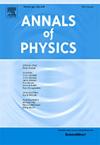旋转AdS黑洞在卡尼达基斯统计中的热力学
IF 3
3区 物理与天体物理
Q2 PHYSICS, MULTIDISCIPLINARY
引用次数: 0
摘要
在这项研究中,我们应用Kaniadakis (KD)熵框架研究了旋转反德西特(AdS)黑洞的热力学性质和相变。为了实现这一点,我们分析了三个著名的旋转AdS黑洞系统:Kerr AdS黑洞,Kerr- sen AdS黑洞和Kerr- newman AdS黑洞。我们在Kaniadakis统计框架内评估它们的热力学量、相变、热力学拓扑和热力学几何。我们观察到,Kaniadakis熵引入了一个熵界,超过这个熵界,黑洞解就会变得热不稳定,这与吉布斯-玻尔兹曼框架不同,后者的稳定性在无限的贝肯斯坦-霍金熵范围内持续存在。这个边界由Kaniadakis参数κ控制,较小的κ值允许在更宽的熵范围内保持稳定。为了说明这些变化,我们研究了自由能景观,它突出了黑洞相结构和稳定性的变化。热力学拓扑进一步表明,当从GB统计转换到KD统计时,这些黑洞的拓扑类别从1变为0。随着拓扑电荷的变化,产生点和湮灭点的数量也会发生变化。值得注意的是,在GB和KD统计中,拓扑电荷仍然独立于所有热力学参数。我们使用两种不同的形式:Ruppeiner和geometrothermodynamics (GTD)来讨论旋转AdS黑洞的热力学几何。我们的分析揭示了在两个框架内标量曲率的不相等数量的奇点。在Ruppeiner的形式中,这些奇点与热容曲线中观察到的不连续点不一致。相比之下,GTD的形式表明,标量曲率的奇异点与热容曲线的不连续点一致。本文章由计算机程序翻译,如有差异,请以英文原文为准。
Thermodynamics of rotating AdS black holes in Kaniadakis statistics
In this study, we investigate the thermodynamic properties and phase transitions in rotating anti-de Sitter (AdS) black holes by applying the Kaniadakis (KD) entropy framework. To achieve this, we analyze three prominent rotating AdS black hole systems: the Kerr AdS black hole, the Kerr-Sen AdS black hole, and the Kerr–Newman AdS black hole. We assess their thermodynamic quantities, phase transitions, thermodynamic topology and thermodynamic geometry within the Kaniadakis statistical framework. We observed that Kaniadakis entropy introduces an entropy bound beyond which the black hole solutions become thermally unstable, unlike the Gibbs–Boltzmann framework, where stability persists across infinite Bekenstein–Hawking entropy range. This bound is controlled by the Kaniadakis parameter , with smaller values allowing stability over a broader entropy range. To illustrate these changes, we examine the free energy landscape, which highlights alterations in the phase structure and the stability of black holes. Thermodynamic topology further indicates that the topological class of these black holes changes from 1 to 0 when transitioning from GB to KD statistics. Along with changes in the topological charge, the number of creation and annihilation points also changes. Notably, the topological charge remains independent of all thermodynamic parameters in both GB and KD statistics. We discuss the thermodynamic geometry of rotating AdS black holes using two different formalisms: Ruppeiner and Geometrothermodynamic (GTD). Our analysis uncovers unequal number of singularities in the scalar curvature within both frameworks. In the Ruppeiner formalism, these singularities do not coincide with the discontinuities observed in the heat capacity curves. In contrast, the GTD formalism shows that the singularities in the scalar curvature align with the discontinuities in the heat capacity curves.
求助全文
通过发布文献求助,成功后即可免费获取论文全文。
去求助
来源期刊

Annals of Physics
物理-物理:综合
CiteScore
5.30
自引率
3.30%
发文量
211
审稿时长
47 days
期刊介绍:
Annals of Physics presents original work in all areas of basic theoretic physics research. Ideas are developed and fully explored, and thorough treatment is given to first principles and ultimate applications. Annals of Physics emphasizes clarity and intelligibility in the articles it publishes, thus making them as accessible as possible. Readers familiar with recent developments in the field are provided with sufficient detail and background to follow the arguments and understand their significance.
The Editors of the journal cover all fields of theoretical physics. Articles published in the journal are typically longer than 20 pages.
 求助内容:
求助内容: 应助结果提醒方式:
应助结果提醒方式:


